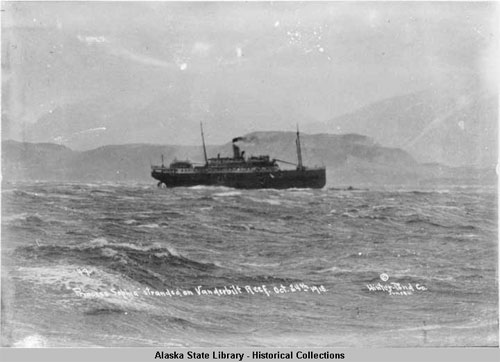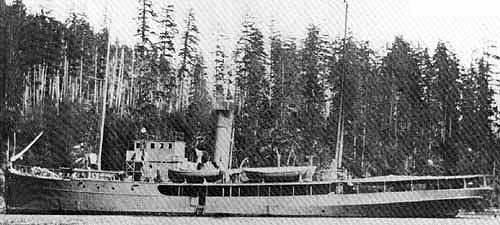 Hundreds died when 'hurricane" raked the North Coast By DAVE KIFFER October 25, 2008
The tide had finally turned in World War I and newspapers were full of stories about the war - which would end in November - winding down. Interest was also on the growing international influenza epidemic that was moving, community by community, up the coast. In time, the Great Influenza, as it was called would kill more than 50 million people world-wide, more than twice the number that died as a result of the war. In October, 1918, though, the spreading epidemic was still more of a fear than a reality, especially in Canada and Alaska. But off the coast was a more immediate danger. And - in an era before weather satellites and accurate forecasts - it was totally unknown. The severe storm would lash the area for than a week with winds estimated at well over 100 knots and seas reaching 45 feet. It would cause immeasurable damage to communities up and down the coast. But worst of all it would sink numerous ships including a large Canadian Coast Guard vessel and one of the largest steamships on the Inside Passage run. Hundreds of lives would be lost.  Photograph courtesy Alaska State Library - Historical Collections Editor's Note: For more information on the Princess Sophia tragedy see "The Grounding of the Princess Sophia" SITNEWS, Dec. 5, 2005.
The storm had already begun to come ashore when the 245-foot Canadian Pacific steamship pulled away from the dock in Skagway at 10:30 pm on October 23, 1918. On board were more than 350 passengers and crew, more than 100 more than normal because it was one of the last ships south before winter closed the Inside Passage passenger service. About half way down Lynn Canal, the ship was enveloped by a blizzard and the winds picked up significantly. Soon they were measured at more than 50 knots. Five hours after leaving Skagway, the ship ran up hard aground on Vanderbilt Reef, some 30 miles north of Juneau. With the wind still rising - it was estimated to have reached nearly 75 knots in Juneau - and rough seas, the captain of the Sophia chose not to try to evacuate the passengers to several smaller ships. Captain Leonard Locke had been helming ships on the North Coast run for 16 years and had been through several groundings. He decided it would be safer to wait until the tide rose and lifted the ship off the rocks. It was a fatal mistake. Throughout the day of October 24, the weather continued to worsen and it became impossible for the ships standing by to even remain near the stranded steamship. They eventually sought cover in nearby islands. Meanwhile, news of the grounding had spread up and down the coast, but the official word was that the ship was resting comfortably on the rocks and would soon be re-floated. The stories that appeared in the Juneau, Prince Rupert and Seattle newspapers, indicated it was nothing more than a routine grounding. But the storm continued to worsen, barometers in Juneau and Sitka dropped precipitously and the waves in southern Lynn Canal topped 35 feet. As darkness fell around 5 pm on Oct. 25, the storm reached its peak. The ship slowly lifted off the rocks, turned around and almost immediately sank into the deeper waters. The only survivor was an English spaniel that was found shivering on a beach nearly 13 miles from the wreck. By now, the storm was also lashing the coast as far south as Ketchikan. The Prince Rupert Daily News reported that the Canadian halibut schooner Helgoland had sunk in Tongass Narrows. The Daily Alaska Empire in Juneau reported that three unidentified fishing vessel were missing and presumed lost between Ketchikan and Petersburg. The Daily Progessive Miner of Ketchikan was not reporting on the storm, or much of anything else at the time. Both of its employees were sick with the influenza and one would later die.  Photo courtesy Canadian Navy
The sinking of the Princess Sophia headline news throughout the U.S. and Canada. But it was front page news in Prince Rupert for only a single day. By Oct. 28, the front page of the Prince Rupert Daily News was full of stories about a more local tragedy. On Oct. 27, the 160-foot HMCS Galiano and her 39 crew members was on patrol in Queen Charlotte Sound south of Prince Rupert. The same storm that had wracked Southeast Alaska was now off the central B.C. coast bringing 70 knot winds and 30 foot seas. The crew of the steamer Prince Albert later reported to the Prince Rupert Daily News that coming across from the Queen Charlotte Islands during the storm it had faced the largest seas and highest winds that any of the crew had ever seen in the area. Farther south, the crew of Galiano managed to get off a single radio message that was picked up by a nearby lighthouse station. "Hold's full of water, for God's sake send help." That was all that was heard from the ship. The Canadian coast guard and numerous private vessels combed the shoreline and waters for several weeks. Eventually the bodies of three crewmen were found as well as an empty lifeboat and a hatch skylight. The Canadian government was never able to determine a cause for the sinking besides the severe weather. The Galiano was later honored
as the only Canadian warship sunk during World War I, even though
its loss did not involve in enemy action.
On the Web:
Dave Kiffer is a freelance writer living in Ketchikan, Alaska. To republish this article, the author requires a publication fee. Contact Dave at dave@sitnews.us
|